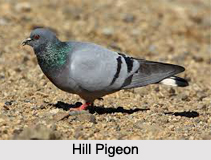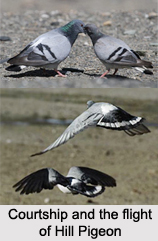 Hill Pigeon is an Indian Bird, which is also known as eastern rock dove or Turkestan hill dove that bears a scientific name "Columba rupestris".
Hill Pigeon is an Indian Bird, which is also known as eastern rock dove or Turkestan hill dove that bears a scientific name "Columba rupestris".
Size of Hill Pigeon
Hill Pigeon is a stout bodied pigeon. It is very similar in size and general appearance to the rock pigeon, but mainly differentiated by its tail pattern which consists of a broad white tail-band across the black tail. Other differences include a paler mantle and upper wings and a white patch on the back. In flight, the tail pattern is similar to the snow pigeon, but lacks the contrast between the head and neck in that species.
Concentration of Hill Pigeon
Hill Pigeon is found in China, Pakistan, India, Nepal, Kazakhstan, North Korea, South Korea, Mongolia, Russia, Tajikistan, Afghanistan and Turkmenistan. This pigeon is comparatively restricted in range of Pakistan to the furthest northern inner valleys of the Karakoram Range, Hindu Kush and Pamirs Knots. In Pakistan it occurs in northern Chitral particularly in the western part bordering Nuristan in Afghanistan, further east in valleys of Gilgit in Yasin and Hunza and Karakoram ranges in Baltistan from about 2000 meters in winter up to 5500 meters during summer months.
Residence of Hill Pigeon
Hill Pigeon frequents open rugged country from 1,500 to 6,100 meters. Closely related to the rock pigeon but more commonly found at higher altitudes.
Behaviour of Hill Pigeon
A gregarious species throughout the year, they feed in flocks in the terraced cultivated fields. They often mix with flocks of rock pigeons. They are very tame and are often found near human settlements, camps and pilgrimage routes.
 Nests of Hilly Pigeon
Nests of Hilly Pigeon
In Tajikistan it has been recorded as starting to nest as early as February with many young just fledging as late as September in north-eastern Tibet. The males have a bowing display similar to that of the rock pigeon and nothing distinctive seems to have been recorded elsewhere about the display of this pigeon which suggests that display and courtship is similar. They nest in dense colonies on cliffs, gorges and rocky outcrops. In Tibet, the nests are often placed houses, both inhabited and empty or in holes in the wall. Nest consists of a platform of twigs or plant stem in which generally two eggs are laid. They may raise two brood in a year.
Feeding Habitats of Hill Pigeon
The feeding habits of hilly pigeons are similar to rock pigeons, being mainly granivorous, supplementing their diet with green shoot and leaves and occasionally small mollusks such as snails. On some occasions, they become very opportunistic, feeding on leftover food, partially digested food from kiang dung and even undigested food from stomach of kiang carcass which are ripped open by other predators.











